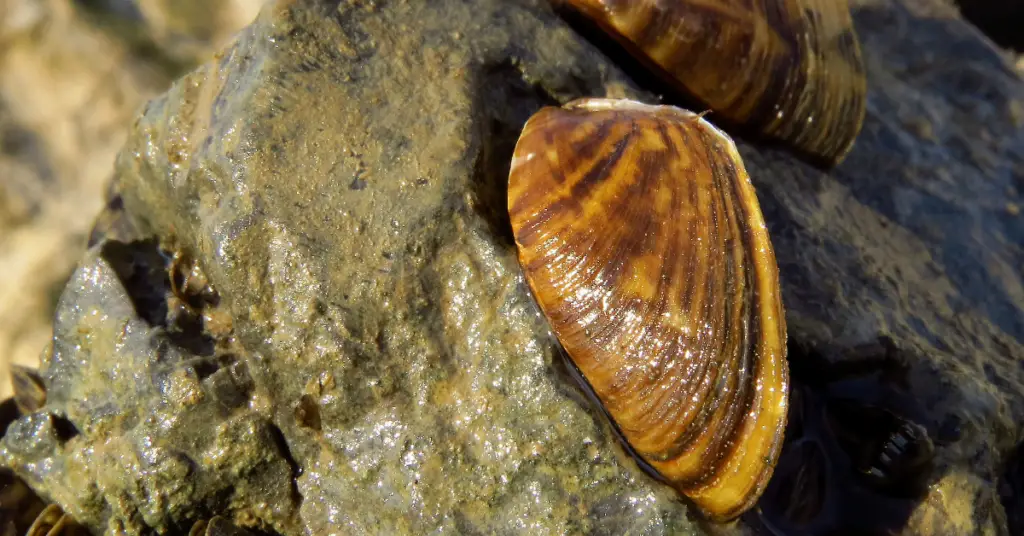Following the discovery of Zebra Mussels in Lake Temiscouata, Quebec, last summer, Fisheries and Oceans Canada (DFO) has been working collaboratively with provincial, municipal, non-governmental, and Indigenous partners to conduct thorough monitoring of lakes and rivers in New Brunswick. This monitoring aims to detect any potential new occurrences of the aquatic invasive species (AIS).
Over the summer, the Department of Fisheries and Oceans (DFO) conducted an analysis of water samples from the Saint John River in New Brunswick using environmental DNA (eDNA) testing. These samples indicated the potential presence of Zebra Mussels, particularly in the regions of Edmundston, Grand Falls, and Nackawic, New Brunswick.
More recently, a collaborative monitoring effort in these areas resulted in the live sighting of Zebra Mussels near a hydroelectric dam in Edmundston. This dam is situated along New Brunswick’s Madawaska River, approximately 40 kilometers downstream from Lake Temiscouata. DFO has officially confirmed that the specimens collected at the dam by the Société d’aménagement de la rivière Madawaska (SARM) in late August 2023 are indeed Zebra Mussels. This marks the first verified observation of this aquatic invasive species in New Brunswick’s waters.
Once established, Zebra Mussels can have detrimental effects on freshwater ecosystems, particularly impacting native mussel species, many of which are already considered at risk. Zebra Mussels outcompete native mussels for food resources, like plankton, and attach themselves to native mussels, ultimately suffocating them. Annually, these invasive mussels cause millions of dollars in damages in Canada, primarily by obstructing intake structures in power stations and water treatment facilities and by causing harm to boats and infrastructure.
Thanks to the initiation of the Aquatic Invasive Species Prevention Fund earlier this year, the Department of Fisheries and Oceans (DFO) is providing support to the Organisme de bassin versant du fleuve Saint-Jean (OBVFSJ) and its partners in the implementation of an Action Plan aimed at curbing the proliferation of Zebra Mussels within the Saint John River watershed.
This joint Action Plan, involving stakeholders from both Quebec and New Brunswick, aims to identify the areas most susceptible to Zebra Mussel infestation and establish a network of boat washing stations in strategic locations. These stations will educate boaters on effective measures to prevent the spread of Zebra Mussels, including proper cleaning, draining, and drying of watercraft. Furthermore, a comprehensive public education and awareness campaign will be launched to promote best practices in controlling the spread of this aquatic invasive species.
The introduction and propagation of aquatic invasive species pose a significant and swiftly escalating global, national, and local threat. In New Brunswick, seamless cooperation between the federal and provincial governments is essential to effectively manage and control aquatic invasive species while safeguarding fish and their habitats throughout the province.
We urge the public to remain vigilant, educate themselves on preventing the spread of Zebra Mussels, and promptly report any Zebra Mussel sightings to either DFO or the New Brunswick Invasive Species Council (NBISC). We also advise against the consumption of Zebra Mussels.

Some Facts
- Aquatic invasive species (AIS) refer to fish, invertebrates, or plants that are not native to a particular aquatic environment and have been introduced beyond their natural habitat. These invaders present a significant danger to the biodiversity of Canada’s aquatic ecosystems, its economy, and society as a whole.
- Environmental DNA (eDNA) sampling serves as a valuable tool in directing the monitoring of Zebra Mussels and other aquatic invasive species. This method enables us to identify the genetic material of a specific species within an ecosystem without the necessity of direct visual confirmation. However, to establish the presence of live specimens in a body of water, a visual observation remains essential.
- Throughout their life cycle, Zebra Mussels can be unintentionally transported from one body of water to another through residual water or by adhering to vessels such as ships, boats, and other watercraft, as well as to maritime and fishing gear like floating docks. In their larval stage, these mussels are minuscule, drifting in the water and being carried along by the currents of lakes and rivers until they affix themselves to a stable surface. It’s important to note that they are a freshwater species.
- The Aquatic Invasive Species Prevention Fund is set to allocate $8.75 million in contribution funding spanning from fiscal years 2022-23 to 2026-27. This funding initiative aims to enhance collaborations among the federal government, provinces, and territories, Indigenous communities, stakeholders, and the general public. These collaborative efforts will support on-the-ground preventative measures against aquatic invasive species, along with activities focused on education, outreach, detection, and response.
- Fisheries and Oceans Canada (DFO) is working with the following non-governmental partners to prevent the spread of Zebra Mussels in New Brunswick: Organisme de bassin versant du fleuve Saint-Jean (OBVFSJ), New Brunswick Invasive Species Council (NBISC), Northwest Regional Service Commission (NRSC), Société d’aménagement de la rivière Madawaska (SARM), Comité de l’aménagement rural du Nord-Ouest (CARNO) and Nature-Loisirs Lac-Baker.








